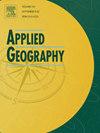Exploring neighborhood daily activity patterns from the perspective of mobility using location-based services data: A case study of Shanghai
IF 5.4
2区 地球科学
Q1 GEOGRAPHY
引用次数: 0
Abstract
The relationship between residents’ daily activities and the built environment has long been a central theme in urban studies, offering valuable insights for planning and neighborhood development. However, conventional static methods often fail to reflect the dynamic nature of these interactions, limiting their relevance for neighborhood renewal. This study addresses this gap by adopting a mobility-based approach that integrates spatial and functional dimensions to explore evolving neighborhood activity patterns. Using Shanghai as a case study, the research first uses Location-Based Services (LBS) data to trace neighborhood travel trajectories and construct a spatial flow network. It then incorporates Points of Interest (POIs) and Areas of Interest (AOIs) data to identify activity types and distributions, building a functional network of neighborhood activities. The study finds that, 1) spatial activity patterns fall into four types: high-density with low aggregation (35 %), low-density with low aggregation (27 %), low-density with high aggregation (23 %), and high-density with high aggregation (15 %); 2) functional patterns also fall into four categories: single-function core (40 %), residential-business dual-core (20 %), multi-function core (25 %), and tourism-driven core (15 %); 3) neighborhoods with similar spatial patterns tend to exhibit corresponding functional characteristics. These spatial and functional patterns help explain how different types of activities are connected and reflected in the physical layout. Aligning spatial design with activity patterns can improve how neighborhoods support residents’ daily needs. The findings offer practical guidance for resident-centered neighborhood renewal, particularly in the design and enhancement of public space elements.
基于位置服务数据的移动视角下社区日常活动模式研究——以上海市为例
长期以来,居民日常活动与建筑环境之间的关系一直是城市研究的中心主题,为规划和社区发展提供了宝贵的见解。然而,传统的静态方法往往不能反映这些相互作用的动态性质,限制了它们与社区更新的相关性。本研究采用基于流动性的方法,结合空间和功能维度来探索不断演变的社区活动模式,从而解决了这一差距。本研究以上海市为例,首先利用基于位置服务(LBS)的数据追踪邻里出行轨迹,构建空间流网络。然后,它结合兴趣点(poi)和兴趣区域(aoi)数据来识别活动类型和分布,建立一个社区活动的功能网络。研究发现:①空间活动格局可分为高密度低聚集型(35%)、低密度低聚集型(27%)、低密度高聚集型(23%)和高密度高聚集型(15%)四种类型;2)功能模式也分为四类:单功能核心(40%)、商住双核(20%)、多功能核心(25%)和旅游驱动型核心(15%);3)空间格局相似的社区往往表现出相应的功能特征。这些空间和功能模式有助于解释不同类型的活动如何相互联系并反映在物理布局中。将空间设计与活动模式结合起来可以改善社区对居民日常需求的支持。研究结果为以居民为中心的社区更新,特别是公共空间元素的设计和增强提供了实践指导。
本文章由计算机程序翻译,如有差异,请以英文原文为准。
求助全文
约1分钟内获得全文
求助全文
来源期刊

Applied Geography
GEOGRAPHY-
CiteScore
8.00
自引率
2.00%
发文量
134
期刊介绍:
Applied Geography is a journal devoted to the publication of research which utilizes geographic approaches (human, physical, nature-society and GIScience) to resolve human problems that have a spatial dimension. These problems may be related to the assessment, management and allocation of the world physical and/or human resources. The underlying rationale of the journal is that only through a clear understanding of the relevant societal, physical, and coupled natural-humans systems can we resolve such problems. Papers are invited on any theme involving the application of geographical theory and methodology in the resolution of human problems.
 求助内容:
求助内容: 应助结果提醒方式:
应助结果提醒方式:


